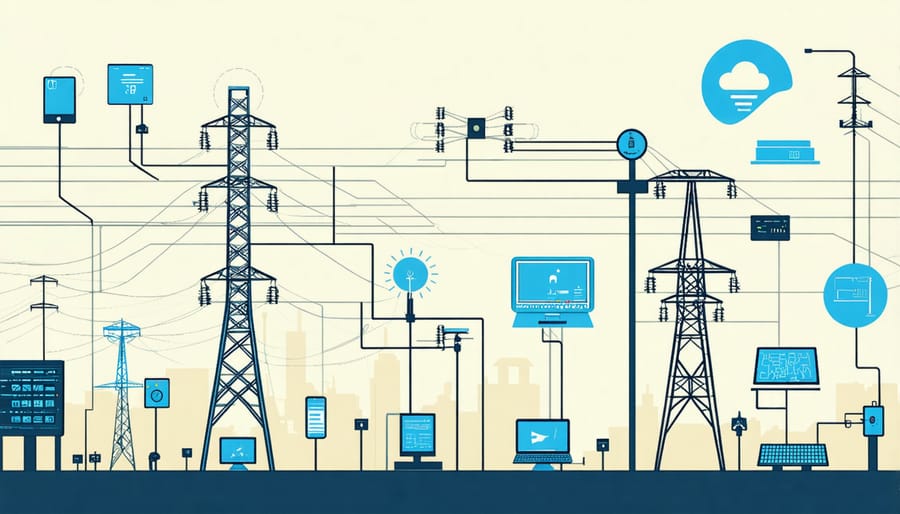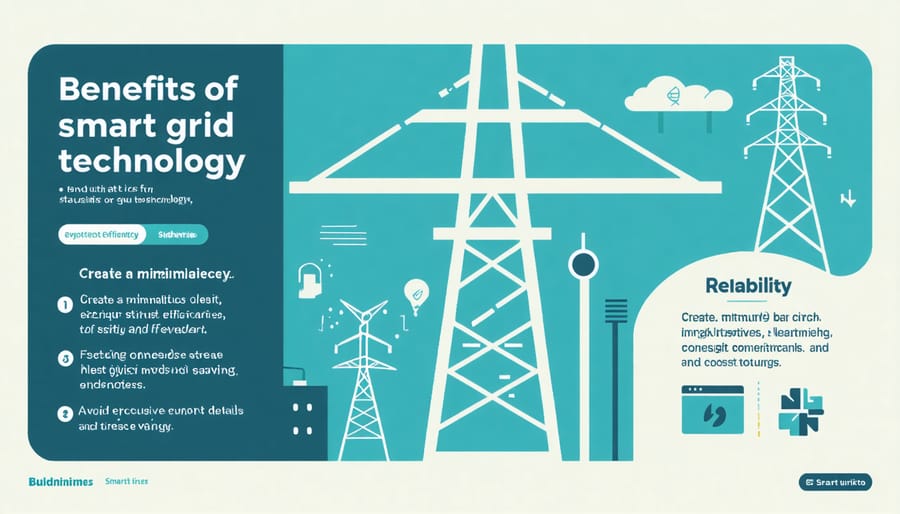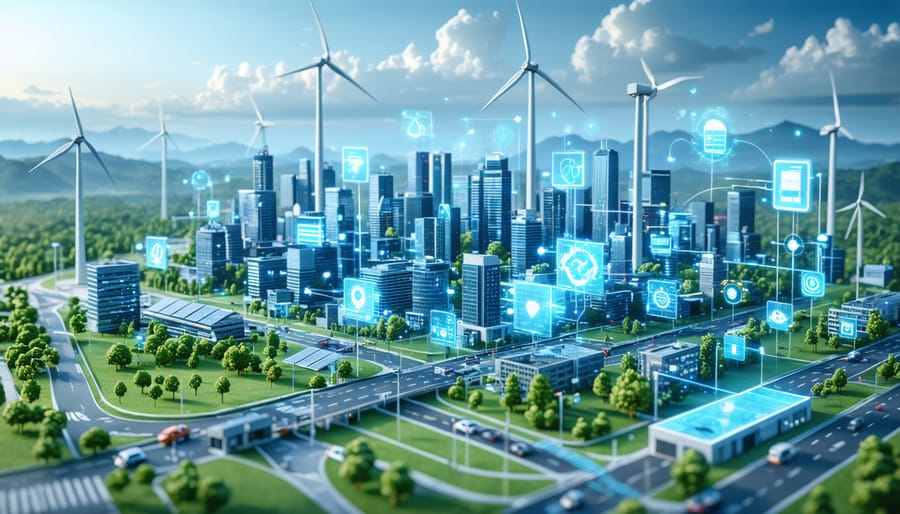Discover the power of smart grid energy—a revolutionary approach to electricity distribution that is transforming the energy landscape. By leveraging advanced technologies, real-time data, and two-way communication, smart grids are ushering in a new era of efficiency, reliability, and sustainability. This intelligent network empowers consumers to become active participants in energy management, enabling them to optimize consumption, reduce costs, and integrate renewable energy sources seamlessly. As we navigate the challenges of climate change and the growing demand for clean energy, smart grids offer a compelling solution, paving the way for a more resilient, adaptable, and environmentally friendly energy future.
What is a Smart Grid?
Key Components of a Smart Grid
A smart grid energy system consists of several key components that work together to enable efficient, reliable, and sustainable power distribution. At the core of the smart grid are smart meters, which provide real-time, two-way communication between the utility and consumers. These advanced meters allow for accurate monitoring of energy consumption, enabling demand response programs and dynamic pricing.
Sensors and automation technologies are also crucial elements of a smart grid. Sensors deployed throughout the grid infrastructure collect data on power flow, voltage levels, and equipment health. This data is processed by intelligent automation systems, which can detect and respond to issues in real-time, such as isolating faults and rerouting power to minimize disruptions.
Robust communication networks, including wireless and fiber-optic technologies, form the backbone of the smart grid. These networks facilitate seamless data exchange between various components, enabling real-time monitoring, control, and optimization of the grid. Advanced software platforms and data analytics tools process the vast amounts of data generated by the smart grid, providing insights for improved grid management and decision-making.
Other essential components include distributed energy resources (DERs) like solar panels, wind turbines, and energy storage systems, which can be efficiently integrated into the smart grid. Advanced control systems and power electronics ensure the smooth integration and management of these renewable energy sources.

Benefits of Smart Grid Technology
The implementation of smart grid technology offers numerous benefits that revolutionize the way energy is generated, distributed, and consumed. One of the most significant advantages is improved efficiency. Smart grids enable real-time monitoring and optimization of energy flow, reducing transmission losses and ensuring that energy is delivered where it is needed most. This enhanced efficiency translates into cost savings for both utility companies and consumers.
Smart grids also significantly improve the reliability and stability of the energy supply. With advanced sensors and communication systems, smart grids can quickly detect and isolate faults, minimizing the impact of power outages. This increased reliability is crucial for critical infrastructure, such as hospitals and data centers, which require a constant and uninterrupted power supply.
Moreover, smart grids facilitate the integration of renewable energy sources, such as solar and wind power, into the existing energy infrastructure. By effectively managing the variability and intermittency of these sources, smart grids ensure a stable and consistent energy supply. This integration not only reduces reliance on fossil fuels but also contributes to the reduction of greenhouse gas emissions, promoting a more sustainable and environmentally friendly energy system.
Smart grid technology also empowers consumers to become active participants in the energy market. With smart meters and ultra-efficient home energy management systems, consumers can monitor their energy consumption in real-time, adjust their usage patterns, and even sell excess energy back to the grid. This level of engagement and control not only helps individuals save on their energy bills but also contributes to the overall efficiency and stability of the energy system.

How Smart Grids Work
Real-time Monitoring and Control
Real-time monitoring and control are fundamental aspects of smart grid technology that enable efficient energy management and grid stability. Advanced sensors, meters, and communication networks continuously collect and transmit data on energy generation, transmission, and consumption. This real-time data provides grid operators with a comprehensive view of the system’s performance, allowing them to dynamically adjust supply and demand, prevent outages, and respond to emergencies.
Smart grids utilize sophisticated algorithms and control systems to analyze the real-time data and make intelligent decisions. By monitoring energy flow, grid operators can detect and isolate faults, reroute power to minimize disruptions, and maintain optimal grid performance. This proactive approach reduces the risk of widespread blackouts and ensures a more reliable energy supply for consumers.
Moreover, real-time monitoring enables smart grids to integrate renewable energy sources more effectively. As the output from solar and wind power can be intermittent and variable, smart grids continuously monitor their contribution to the grid and make necessary adjustments to maintain stability. By dynamically balancing the mix of traditional and renewable energy sources, smart grids optimize the use of clean energy while ensuring a consistent power supply.
In emergency situations, such as extreme weather events or equipment failures, smart grids leverage real-time data to quickly identify and respond to issues. Operators can remotely control grid components, such as switches and circuit breakers, to isolate affected areas and restore power more efficiently. This rapid response capability minimizes the impact of emergencies on consumers and critical infrastructure.
Real-time monitoring and control are essential for the successful implementation of smart grid energy. By enabling continuous system oversight, dynamic adjustments, and rapid response to challenges, smart grids enhance grid reliability, efficiency, and resilience in the face of an increasingly complex and distributed energy landscape.
Two-way Communication and Automation
One of the key features of smart grids is their ability to enable two-way communication between utilities and consumers. This bidirectional communication allows for real-time data exchange, enabling utilities to monitor energy consumption patterns, identify potential issues, and optimize energy distribution. Smart meters, installed at consumer premises, play a crucial role in this communication process by transmitting usage data to the utility company and receiving important information such as pricing signals or emergency alerts.
The two-way communication facilitated by smart grids also enables automated demand response and load management. During peak demand periods or when the grid is under stress, utilities can send signals to smart devices and appliances in consumers’ homes or businesses to automatically adjust their energy consumption. For example, smart thermostats can receive signals to slightly adjust temperature settings, while smart appliances can delay their operation to off-peak hours. This automated demand response helps balance the grid’s load, reduces the need for expensive peak power generation, and minimizes the risk of blackouts or brownouts.
Moreover, the data collected through smart grid communication allows utilities to implement dynamic pricing models, such as time-of-use or real-time pricing. Consumers can access this information through web portals or mobile apps, empowering them to make informed decisions about their energy usage and potentially save money by shifting their consumption to off-peak periods. This level of transparency and control encourages consumers to become active participants in the energy market, promoting energy efficiency and conservation.

The Future of Smart Grids
Integration with Renewable Energy
Smart grids play a crucial role in integrating distributed renewable energy sources, such as solar and wind power, into the existing electrical infrastructure. By leveraging advanced sensing, communication, and control technologies, smart grids enable the seamless incorporation of these intermittent energy sources. Through two-way communication between energy producers and consumers, smart grids can dynamically balance supply and demand, ensuring grid stability even with the variable nature of renewable energy generation. Smart inverters and advanced metering infrastructure allow for the efficient management of energy flow from distributed renewable sources, enabling real-time monitoring and control. This integration not only reduces reliance on fossil fuels but also empowers consumers to become active participants in the energy market by generating their own clean energy and selling excess power back to the grid. As the adoption of renewable energy continues to grow, smart grids will be essential in facilitating their seamless integration, paving the way for a more sustainable and resilient energy future in the construction industry and beyond.
Challenges and Opportunities
The widespread implementation of smart grid energy systems presents both challenges and opportunities. From a technical standpoint, integrating advanced sensors, communication networks, and data analytics into existing power infrastructure can be complex and costly. Ensuring the security and privacy of the vast amounts of data generated by smart grids is another significant challenge. Regulatory hurdles, such as outdated policies and inconsistent standards across regions, can hinder the adoption of smart grid technologies. Societal challenges include educating consumers about the benefits of smart grids and addressing concerns about data privacy and control.
Despite these challenges, the transition to smart grid energy offers numerous opportunities for innovation and growth. The development of advanced metering infrastructure, energy storage solutions, and demand response programs can drive technological advancements and create new market opportunities. Smart grids also enable the integration of renewable energy sources, such as solar and wind power, leading to a cleaner and more sustainable energy future. As the demand for energy efficiency and reliability grows, the implementation of smart grids can spur job creation and economic growth across various sectors, including construction, manufacturing, and IT. By embracing construction innovations and collaborating with stakeholders, the industry can overcome challenges and unlock the full potential of smart grid energy systems.
Conclusion
Smart grid energy represents a transformative shift in the energy industry, offering a more efficient, reliable, and sustainable approach to power generation, distribution, and consumption. By leveraging advanced technologies, real-time data, and bi-directional communication, smart grids enable better management of energy resources, reduced environmental impact, and cost savings for both utilities and consumers. The integration of renewable energy sources, energy storage systems, and demand response programs further enhances the flexibility and resilience of smart grids, making them a crucial component in the transition to a cleaner and more sustainable energy future. As the world faces increasing energy demands and the urgent need to address climate change, the adoption of smart grid energy becomes imperative. It not only improves grid stability and energy efficiency but also empowers consumers to actively participate in energy management, fostering a more engaged and environmentally conscious society. With ongoing advancements in smart grid technologies and supportive policies, the future of the energy industry looks promising, paving the way for a smarter, greener, and more reliable energy ecosystem that benefits both the planet and its inhabitants. Embracing smart grid energy is not just a choice but a necessity for shaping a sustainable and prosperous future.

